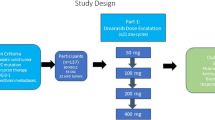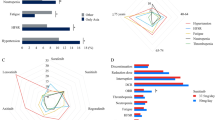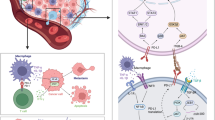Abstract
Background
Currently, the only FDA-approved systemic therapy for hepatocellular carcinoma (HCC) is the multi-receptor tyrosine kinase inhibitor, sorafenib, which provides only modest clinical benefit. We recently showed that treatment with a phosphatidylserine (PS) targeting agent suppresses tumor growth by targeting tumor vasculature and reactivating antitumor immunity.
Methods
We tested the hypothesis that sorafenib increases PS exposure on tumor vasculature, thereby enhancing the antitumor efficacy of PS targeting. We evaluated the efficacy of combining a PS targeting agent (2aG4) with sorafenib in murine xenograft models of human HCC.
Results
Our results demonstrate that combination of 2aG4 and sorafenib had a superior therapeutic effect over single agent therapy. Mechanistic studies showed that sorafenib significantly increased PS exposure on tumor vasculature; the percentage of PS-positive vessels increased from 19 to 52, 23 to 68, and 30 to 55 % in PLC/PRF/5, C3A, and Huh7 tumors, respectively. Combination therapy significantly decreased tumor microvessel density and the level of M2 macrophages, while increasing the apoptotic index of tumor endothelial cells and the frequency of M1 macrophages. Furthermore, we report the findings of a Phase I clinical study of bavituximab, a chimeric version of 2aG4, combined with sorafenib in HCC patients. The Phase I results demonstrate the appropriate dose of bavituximab to be given with sorafenib in future clinical trials.
Conclusions
Overall, these results strongly support the combination of bavituximab with sorafenib as a promising systemic therapeutic strategy for the treatment for advanced HCC patients.





Similar content being viewed by others
References
Jemal A, Bray F, Center MM, Ferlay J, Ward E, Forman D. Global cancer statistics. CA Cancer J Clin. 2011;61(2):69–90.
El-Serag HB. Hepatocellular carcinoma. N Engl J Med. 2011;365(12):1118–27.
Wilhelm SM, Carter C, Tang L, et al. BAY 43-9006 exhibits broad spectrum oral antitumor activity and targets the RAF/MEK/ERK pathway and receptor tyrosine kinases involved in tumor progression and angiogenesis. Cancer Res. 2004;64(19):7099–109.
Cheng AL, Kang YK, Chen Z, et al. Efficacy and safety of sorafenib in patients in the Asia-Pacific region with advanced hepatocellular carcinoma: a phase III randomised, double-blind, placebo-controlled trial. Lancet Oncol. 2009;10(1):25–34.
Cheng AL, Kang YK, Lin DY, et al. Sunitinib versus sorafenib in advanced hepatocellular cancer: results of a randomized phase III trial. J Clin Oncol. 2013.
Llovet JM, Ricci S, Mazzaferro V, et al. Sorafenib in advanced hepatocellular carcinoma. N Engl J Med. 2008;359(4):378–90.
Maluccio M, Covey A. Recent progress in understanding, diagnosing, and treating hepatocellular carcinoma. CA Cancer J Clin. 2012;62(6):394–9.
Thorpe PE. Targeting anionic phospholipids on tumor blood vessels and tumor cells. Thromb Res. 2010;125(2):S134–7.
Biermann M, Maueroder C, Brauner JM, et al. Surface code-biophysical signals for apoptotic cell clearance. Phys Biol. 2013;10(6):065007.
Frey B, Gaipl US. The immune functions of phosphatidylserine in membranes of dying cells and microvesicles. Semin Immunopathol. 2011;33(5):497–516.
Birge RB, Ucker DS. Innate apoptotic immunity: the calming touch of death. Cell Death Differ. 2008;15(7):1096–102.
Fonseca C, Dranoff G. Capitalizing on the immunogenicity of dying tumor cells. Clin Cancer Res. 2008;14(6):1603–8.
Beck AW, Luster TA, Miller AF, et al. Combination of a monoclonal anti-phosphatidylserine antibody with gemcitabine strongly inhibits the growth and metastasis of orthotopic pancreatic tumors in mice. Int J Cancer. 2006;118(10):2639–43.
He J, Yin Y, Luster TA, Watkins L, Thorpe PE. Antiphosphatidylserine antibody combined with irradiation damages tumor blood vessels and induces tumor immunity in a rat model of glioblastoma. Clin Cancer Res. 2009;15(22):6871–80.
Huang X, Bennett M, Thorpe PE. A monoclonal antibody that binds anionic phospholipids on tumor blood vessels enhances the antitumor effect of docetaxel on human breast tumors in mice. Cancer Res. 2005;65(10):4408–16.
Ran S, He J, Huang X, Soares M, Scothorn D, Thorpe PE. Antitumor effects of a monoclonal antibody that binds anionic phospholipids on the surface of tumor blood vessels in mice. Clin Cancer Res. 2005;11(4):1551–62.
Yin Y, Huang X, Lynn KD, and Thorpe PE. Phosphatidylserine-targeting antibody induces m1 macrophage polarization and promotes myeloid-derived suppressor cell differentiation. Cancer Immunol Res. 2013;1(4):256–68.
Luster TA, He J, Huang X, et al. Plasma protein beta-2-glycoprotein 1 mediates interaction between the anti-tumor monoclonal antibody 3G4 and anionic phospholipids on endothelial cells. J Biol Chem. 2006;281(40):29863–71.
Gerber DE, Stopeck At, Fau-Wong L, Wong L, Fau-Rosen LS, et al. Phase I safety and pharmacokinetic study of bavituximab, a chimeric phosphatidylserine-targeting monoclonal antibody, in patients with advanced solid tumors. 20111102 DCOM-20120120 (1078–0432 (Print)).
Stafford JH, Hao G, Best AM, Sun X, Thorpe PE. Highly specific PET imaging of prostate tumors in mice with an iodine-124-labeled antibody fragment that targets phosphatidylserine. PLoS one. 2013;8(12):e84864.
Liu L, Cao Y, Chen C, et al. Sorafenib blocks the RAF/MEK/ERK pathway, inhibits tumor angiogenesis, and induces tumor cell apoptosis in hepatocellular carcinoma model PLC/PRF/5. Cancer Res. 2006;66(24):11851–8.
Di Marco V, De Vita F, Koskinas J, Semela D, Toniutto P, Verslype C. Sorafenib: from literature to clinical practice. Ann Oncol. 2013;24 Suppl 2:ii30–7.
Acknowledgment
The authors thank Dan Ye and Janie Iglehart for technical assistance and Drs. Marietta Kovacs and Alan Schroit for discussions and comments on the manuscript. This work was initiated under the direction of Dr. Philip Thorpe, who unfortunately passed away suddenly in March 2013. This work was supported by a sponsored research agreement with Peregrine Pharmaceuticals Inc. (Tustin, CA).
Author information
Authors and Affiliations
Corresponding authors
Additional information
Xiaoyun Cheng and Li Li have contributed equally to this work.
Rolf Brekken and Xianming Huang are consultants to, have equity interest in, and have a sponsored research agreement with Peregrine Pharmaceuticals Inc.
Electronic supplementary material
Below is the link to the electronic supplementary material.
Rights and permissions
About this article
Cite this article
Cheng, X., Li, L., Thorpe, P.E. et al. Antibody-Mediated Blockade of Phosphatidylserine Enhances the Antitumor Effect of Sorafenib in Hepatocellular Carcinomas Xenografts. Ann Surg Oncol 23 (Suppl 5), 583–591 (2016). https://doi.org/10.1245/s10434-016-5107-5
Received:
Published:
Issue Date:
DOI: https://doi.org/10.1245/s10434-016-5107-5




